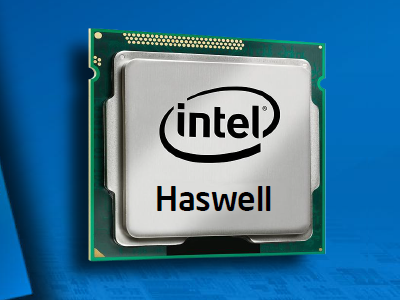Intel: Haswell Provides 50% More Battery Life in Notebooks
Rani Borkar, corporate vice president and general manager of the Intel Architecture Group, said in a media briefing on Thursday that Intel's upcoming family of "Haswell" Core mobile processors will provide 50 percent more battery life in laptops than the previous Ivy Bridge generation. That's because the chips were designed with the power-saving needs of notebooks and tablets in mind.
But let's get real here for a moment: the CPU is just one of many power-hungry components in a laptop. To get a significant jump in battery life, the display will need to be more efficient too. However Haswell will supposedly make a noticeable difference thanks to new low power states, a full-integrated voltage regulator, faster interconnects and 20 nm process technology.
Intel claims Haswell will perform even better when in idle or standby mode, extending battery life by up to 20 times than what current processors can manage on laptops and hybrids. Borkar told reporters in the media briefing that there won’t be a tradeoff of performance for longer battery life with Haswell chips. Even more, they'll offer double the graphics performance for laptops and up.
Intel is slated to launch the new Haswell processors next month during COMPUTEX 2013 in Taipei. They're an attempt to throw the PC sector a lifeline as it struggles against the more power-efficient, more mobile and lightweight tablet and smartphone segments. Haswell will not only offer longer battery life, but encourage more hybrid solutions with touchscreens and detachable keyboards.
Haswell represents an update to Intel's instruction set architecture which it delivers every two years. Borkar said that a Haswell-based tablet will offer similar battery life to a non-Intel tablet, but more performance than a "content consumption" device. Some chips will go as low as 7 watts whereas some of the current-generation Ivy Bridge Core chips can go as low as 10 watts.
Haswell's low-power consumption is partly due to an on-chip power management unit which provides an overall view of energy consumption on the chip. This unit dynamically adjusts the power in various parts of the chip to reduce its overall power draw. Voltage regulators have also been consolidated, enabling smaller Haswell-based motherboards that can be mounted in smaller form factors.
Get Tom's Hardware's best news and in-depth reviews, straight to your inbox.

Kevin Parrish has over a decade of experience as a writer, editor, and product tester. His work focused on computer hardware, networking equipment, smartphones, tablets, gaming consoles, and other internet-connected devices. His work has appeared in Tom's Hardware, Tom's Guide, Maximum PC, Digital Trends, Android Authority, How-To Geek, Lifewire, and others.
-
smeezekitty Thats nice to have. But I think it is time to start working on more efficient backlights.Reply
LED provides an alternative to CCFL and it should be more efficient. -
southernshark I suspect strongly that the difference will be more noticeable in cell phones. I doubt the notebooks are going to be effected that much. And for myself my notebook will still need a GPU, because I'm not using Intel's. I'm also a little suspicious of this claim until we see real world testing. More likely than not Intel means 50 percent less energy, "sometimes" rather than all the time (or rather than a gross savings of 50 percent which would require more than 50 percent savings some of the time).Reply -
teh_chem I don't care what the idle power-saving properties of a processor are. I care about overall in-use power savings. Most processors are already as power-efficient as need be for idle states. But users care about usage states. Claims that the CPU will have THAT big of an impact are...awaiting confirmation...Reply
My smartphone lasts days and days without using the screen. But start using it for things like web browsing and media-watching, and you're lucky to get a day's use thanks to the screen. -
DRosencraft Yeah, will wait to see real-world tests. I expect there will significant power savings, but I'm a little skeptical they'll get that much.Reply -
Fulgurant Reply10861604 said:Yeah, will wait to see real-world tests. I expect there will significant power savings, but I'm a little skeptical they'll get that much.
Right. There won't be a 50% increase in battery life because, as the article mentioned, the CPU is only one component. Still, it's a pretty impressive achievement, even if the CPU-power savings only translate into a 10-15% increase in battery life overall. -
swordrage They said it already. What about the usb3 issue? That could have been a news of interest.Reply -
InvalidError Reply
CCFL has been out of fashion for years already. The majority of laptops across all price segments have switched to LED over a year ago.10861264 said:Thats nice to have. But I think it is time to start working on more efficient backlights.
LED provides an alternative to CCFL and it should be more efficient.
But backlighting itself is inherently inefficient since you generate white light but then scrap 2/3 of the light by passing it through RGB filters for each individual subpixel and then waste 50-100% of the remaining light by blocking it with a polarized crystal matrix. So, while the WLED backlight may be twice as efficient as CCFL, about 90% of the light produced is wasted on average. That's not counting losses within the backlight diffuser itself, bleeding around edges, coupling losses between LEDs and diffuser, etc.
If you want to increase efficiency, you have to ditch backlighting altogether and use emissive technologies like OLED then work on improving those technologies' efficiency, brightness and durability.
